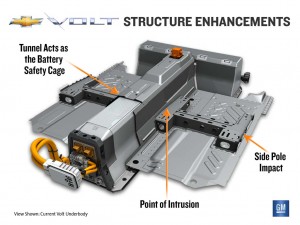
GM will begin modifying Volts on the assembly line immediately, with dealers modifying customer vehicles starting in February.
General Motors will make a series of “enhancements” to ensure there is no risk of its Chevrolet Volt plug-in electric vehicle catching fire after a side-impact crash. The move follows reports last month that several Volt battery packs either caught fire or smoked and sparked several weeks after aggressive crash testing by the National Highway Traffic Safety Administration.
While Mark Reuss, GM’s president of the Americas, said he couldn’t answer for the NHTSA he expressed confidence his company’s announcement will lead government safety regulators to wrap up their investigation into possible problems with the Volt battery pack.
The updates to the Volt will not impact the vehicle’s lithium-ion battery pack itself but will reinforce the vehicle structure to prevent the battery coolant system from being penetrated – as happened in the NHTSA testing – while also reducing the risk coolant fluid could spill onto sensitive electronic components.
“We have made the Volt even safer,” Reuss declared during his remarks, adding that if he didn’t think the Volt was already safe “I wouldn’t allow” his own family to continue using the vehicle on a daily basis.
 GM’s product development chief Mary Barra said the maker’s testing indicates the three reported incidents were triggered by NHTSA crash tests, which included a process in which the battery cars were slowly rolled over, allowing little more than a cup of leaking battery coolant to come in contact with a printed circuit board. In a telephone conference call with reporters, GM officials stressed that they have had no reports of any fires or shorts involving Chevy Volts actually in customer hands even after that fleet has collectively logged more than 20 million miles.
GM’s product development chief Mary Barra said the maker’s testing indicates the three reported incidents were triggered by NHTSA crash tests, which included a process in which the battery cars were slowly rolled over, allowing little more than a cup of leaking battery coolant to come in contact with a printed circuit board. In a telephone conference call with reporters, GM officials stressed that they have had no reports of any fires or shorts involving Chevy Volts actually in customer hands even after that fleet has collectively logged more than 20 million miles.
Along with the changes to the vehicle, GM has revised the procedures to be followed after a serious crash. It now calls for the Volt’s battery to be “de-energized,” or discharged, to further reduce chances of shorting and fires.
“We’re as confident as ever the battery pack and structure are the safest on the market,” echoed Barra.
The modifications will be incorporated into all new Chevrolet Volts produced at a GM plant in Detroit when it wraps up its holiday break and resumes operations later this month. Meanwhile, GM hopes to have parts available so customers can have the modifications made at Chevy dealers starting next month. The small number of Opel Ampera hybrids already shipped overseas will also be subject to the modifications.
There are about 8,000 Volts now in consumer hands, Reuss noted, with another 4,400 in dealer inventories. Those will also need the fix, though the executive said dealers can continue selling those vehicles in the meantime and advise customers to come back later. The modification process is likely to take only a couple hours and GM plans to make loaner vehicles available to owners to minimize the inconvenience.
The maker plans to hold an online meeting with Volt owners on Friday to discuss the latest news.
“The way we treat this and handle this will model how we handle things in the future. General Motors will stop at nothing to ensure customer satisfaction,” Reuss promised.
Notably, the maker is treating the modifications as a voluntary service action, a step short of a full-blown recall, which would have barred the sale of the Chevy Volt until all products were updated.
Since word of the NHTSA fires leaked out last month the subject of Volt safety – indeed of the safety of electric vehicles in general – has been a major media topic. Despite some of the scarier headlines, Reuss declined to criticize the news media for its handling of the story.
He meanwhile insisted that the Chevy Volt, meant to provide a high-tech halo around GM, hasn’t lost its luster, citing third-party surveys that show most owners are extremely satisfied with the vehicle.
He acknowledged about 250 owners have either asked for a refund or taken a temporary loaner until the problem is resolved. He declined to provide a specific breakout but suggested a mere “handful” had turned their vehicle back in.
Sales of the Volt last month belied early speculation that the news reports would short-circuit market demand. On the other hand, the Chevy plug-in ended the year well short of initial expectations that sales would nudge 10,000 for the year.
GM has said it wants to ramp up production to 60,000 Chevrolet Volt and Opel Ampera plug-ins for 2012, 75% earmarked for the U.S. But Reuss stressed that the maker won’t simply push cars out of the plant and then try to figure out how to sell them, insisting it “will match demand with supply.”
And in line with the ongoing debate over public interest in battery technology, he acknowledged “what the true demand is” for electric vehicles remains “unknown.”
